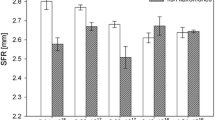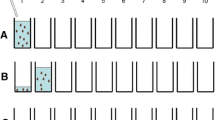Abstract
Swimming in response to light change is considered the proximate mechanism underlying diel vertical migration. This behavioural mechanism is supposed to be tuned to the adaptive needs under natural conditions by the modifying influence of environmental variables, such as predator kairomones. We investigated to what extent fish kairomone level affects downward swimming in response to a continuous relative light intensity increase. At the higher kairomone levels Daphnia had significant higher displacement velocities. Thus, kairomone was perceived quantitatively and behaviour was altered correspondingly. Because the absolute difference in displacement velocity between treatments was small, we assumed that kairomone concentration could not explain much of the seasonal variability in diel vertical migration patterns in Lake Maarsseveen. Therefore, we hypothesised that besides swimming in response to relative changes in light intensity, other aspects of phototaxis were important also. The natural light intensity increase at early morning consists of a continuous increase in the rate of the relative light intensity change, which reach a maximum about 30–45 min before sunrise. After this maximum, the rates of the relative light intensity increase decrease again. Thus far, it was assumed that successive changes in light intensity acted independent on the swimming reaction of the daphnids. In this paper, we present results of experiments with Daphnia swimming in response to a combination of a continuous and an instantaneous increase in light intensity. A continuous relative light increase preceding an instantaneous increase in light intensity (step) enlarged the downward displacement velocity of Daphnia markedly. Hence, successive light stimuli did not act independently. With growing relative light increase rates preceding the step, the displacement velocity increased also. Moreover, the presence of fish kairomone further increased the velocity in response to the light change. Therefore, the rate of the relative change in light intensity is an incomplete description of the stimulus for diel vertical migration behaviour.
Similar content being viewed by others
References
Clarke GL (1930) Change of phototropic and geotropic signs in Daphnia induced by changes of light intensity. J Exp Biol 7: 109–131
Clarke GL (1932) Quantitative aspects of the change of photropic sign in Daphnia J Exp Biol 9: 180–211
Forward RB Jr and Hettler WFJ Jr (1992) Effects of feeding and predator exposure on photoresponses during diel vertical migration of brine shrimp larvae. Limnol Oceanogr 37: 1261–1270
Forward RB Jr and Rittschof D (1993) Activation of photoresponses of brine shrimp nauplii involved in diel vertical migration by chemical cues from fish. J Plankton Res 15: 693–701
Lampert W (1993) Ultimate causes of diel vertical migration of zooplankton: new evidence for the predator avoidance hypothesis. Arch Hydrobiol Beih Ergebn Limnol 39: 79–88
Loose CJ and Dawidowicz P (1994) Trade-offs in diel vertical migration by zooplankton: the costs of predator avoidance. Ecology 75: 2255–2263
Muck P and Lampert W(1984) An experimental study on the importance of food conditions for the relative abundance of calanoid copepods and cladocerans. Arch Hydrobiol Suppl 66: 157–179
Ringelberg J (1964) The positively phototactic reaction of Daphnia magna Straus: a contribution to the understanding of diurnal vertical migration. Neth J Sea Res 2: 841–847
Ringelberg J (1987) Light induced behaviour in Daphnia. Mem Ist Ital Idrobiol 45: 285–323
Ringelberg J (1991) Enhancement of the phototactic reaction in Daphnia hyalina by a chemical mediated by juvenile perch (Perca fluviatilis). J Plankton Res 13: 17–25
Ringelberg J and Flik BJG (1994) Increased phototaxis in the field leads to enhanced diel vertical migration. Limnol Oceanogr 39: 1855–1864
Ringelberg J, Flik BGJ, Aanen D and Van Gool E (1997) Amplitude of diel vertical migration (DVM) is a function of fish biomass, a hypothesis. Arch Hydrobiol Spec Issues Advanc Limnol 49: 71–78
Ringelberg J, Flik BJG, Lindenaar D and Royackers K (1991) Diel vertical migration of Daphnia hyalina sensu latiori in Lake Maarsseveen: Part 1 Aspects of seasonal and daily timing. Arch Hydrobiol 121: 129–145
Van Gool E and Ringelberg J (1995) Swimming of Daphnia galeata x hyalina in response to changing light intensities: influence of food availability and predator kairomone. Mar Fresh Behav Physiol 26: 259–265.
Rights and permissions
About this article
Cite this article
van Gool, E., Ringelberg, J. Quantitative effects of fish kairomones and successive light stimuli on downward swimming responses of Daphnia. Aquatic Ecology 32, 291–296 (1998). https://doi.org/10.1023/A:1009917929959
Issue Date:
DOI: https://doi.org/10.1023/A:1009917929959




